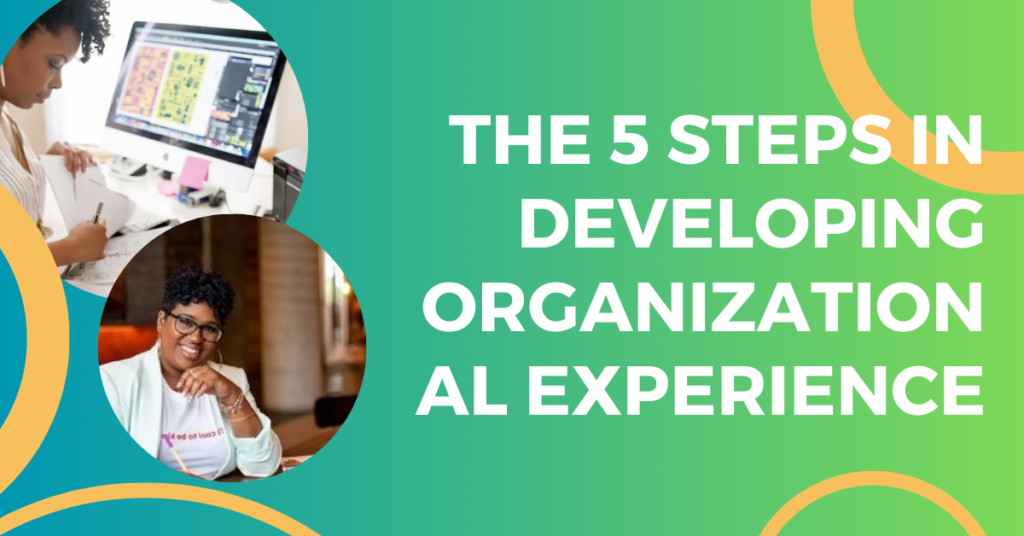
Menu
Facebook-f
Twitter
Google-plus-g
The 5 Steps in Developing Organizational Experience
Developing organizational experience is key to improving how your organization operates and achieves its goals. This experience builds over time through various activities, projects, and lessons learned. Here’s a simple guide on how to develop and enhance organizational experience effectively:
Step 1. Document Your Processes and Procedures
Why Documenting Matters: Documenting your organization’s processes and procedures helps capture valuable knowledge and ensures that important information is not lost when staff members leave or new members join. It also helps maintain consistency and quality in your work.
How to Document:
- Create Manuals: Write detailed guides on how tasks and processes should be carried out. These manuals should be clear and easy to follow.
- Use Checklists: Develop checklists for routine tasks to ensure that all steps are completed and nothing is missed.
- Maintain Records: Keep detailed records of past projects, including the steps taken, challenges faced, and outcomes achieved. This helps in learning from past experiences.
Example:
If your organization runs a community health program, create a manual that outlines each step of the program, from planning and implementation to evaluation. Include checklists for tasks like organizing health workshops or distributing medical supplies.
Step 2. Encourage Continuous Learning
Why Continuous Learning is Important: Encouraging continuous learning helps your organization stay updated with new developments and improve its skills. It ensures that staff members are knowledgeable about the latest trends and best practices in their fields.
How to Encourage Learning:
- Offer Training: Provide regular training sessions for staff on relevant skills and knowledge. This could include workshops, seminars, or online courses.
- Attend Workshops: Encourage staff to attend industry-related workshops and conferences to gain new insights and network with others in the field.
- Promote Knowledge Sharing: Create opportunities for team members to share their knowledge and experiences with each other. This can be through regular meetings or internal presentations.
Example:
If your organization is implementing a new fundraising strategy, offer training sessions on effective fundraising techniques. Invite experts to share their knowledge and provide hands-on practice for your team.
Step 3. Reflect on Past Projects
Why Reflection Matters: Reflecting on past projects helps you understand what worked well and what didn’t. It provides valuable insights that can improve future projects and operations.
How to Reflect:
- Conduct Debriefs: After completing a project, hold debriefing sessions with your team to discuss successes and challenges. These discussions should focus on what went right, what could be improved, and any lessons learned.
- Collect Feedback: Gather feedback from stakeholders, beneficiaries, and team members to understand their perspectives and experiences.
- Analyze Outcomes: Review the project’s outcomes and compare them to the goals set at the beginning. Analyze any gaps and identify areas for improvement.
Example:
After finishing a community outreach event, hold a debriefing meeting with your team to discuss what worked well and what didn’t. Collect feedback from participants and use this information to plan future events more effectively.
Step 4. Build a Knowledge Base
Why a Knowledge Base is Useful: A knowledge base is a centralized repository where your organization can store important information and resources. It helps in sharing best practices and lessons learned across the team.
How to Build a Knowledge Base:
- Create a Central Repository: Use digital tools to store and organize documents, templates, and guides. This can be a shared online platform where team members can easily access information.
- Update Regularly: Ensure that the knowledge base is regularly updated with new information and insights. This keeps it relevant and useful.
- Make it Accessible: Ensure that all team members have easy access to the knowledge base. Provide training on how to use it effectively.
Example:
Develop an online platform where your team can access important documents related to project management, such as templates, best practices, and reports from previous projects. Update this platform regularly with new information and ensure that all team members can use it easily.
Step 5. Foster a Culture of Collaboration
Why Collaboration is Key:
Collaboration encourages team members to share their experiences and expertise. It helps solve problems more effectively and creates a supportive work environment.
How to Foster Collaboration:
- Encourage Teamwork: Promote teamwork by encouraging staff to work together on projects. Create opportunities for team members to collaborate and share their ideas.
- Create Collaborative Spaces: Set up physical or virtual spaces where team members can work together and share information. This could be a dedicated meeting room or an online collaboration tool.
- Recognize Contributions: Acknowledge and reward team members for their contributions and collaborative efforts. This helps motivate staff and fosters a positive work environment.
Example:
Organize regular team meetings where members can discuss project updates, share challenges, and collaborate on solutions. Use online collaboration tools to facilitate communication and teamwork, and recognize team members who contribute valuable ideas and solutions.
Address List
-
Makerere Hill Road, Ham Towers -
+256-703947778 -
info@professionalwriters.shop
Social Networks
Links List
Professional Writers Inc.
Turning Ideas Into Reality
Business Plan Writing Training [Free]





